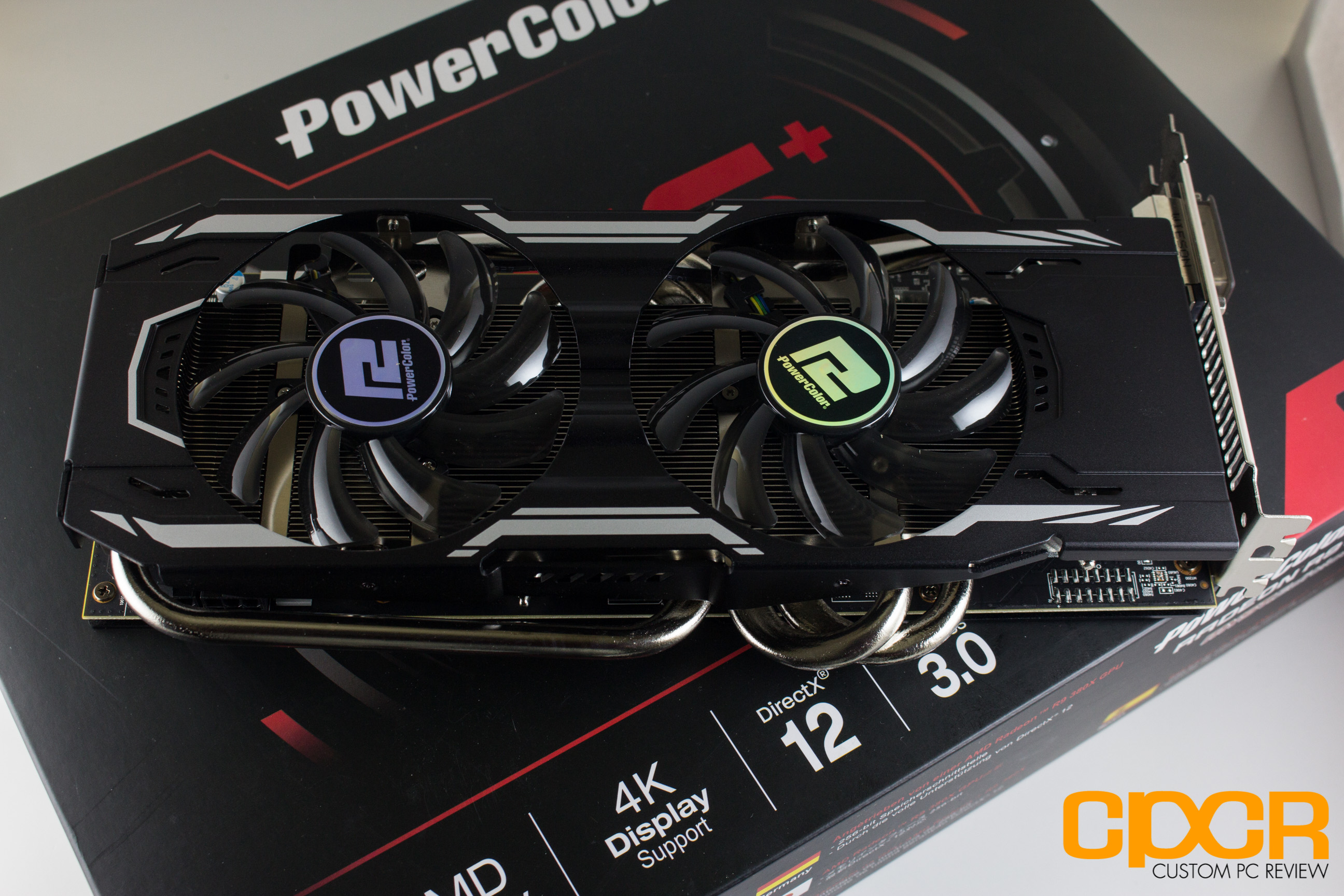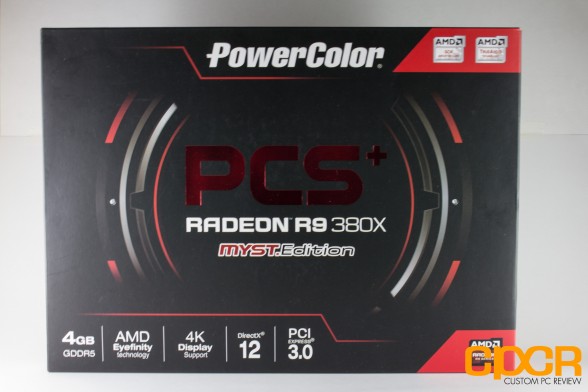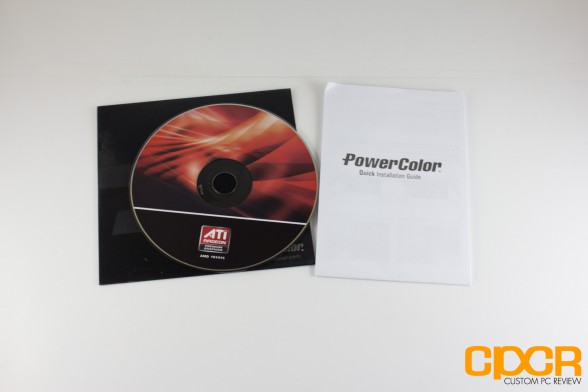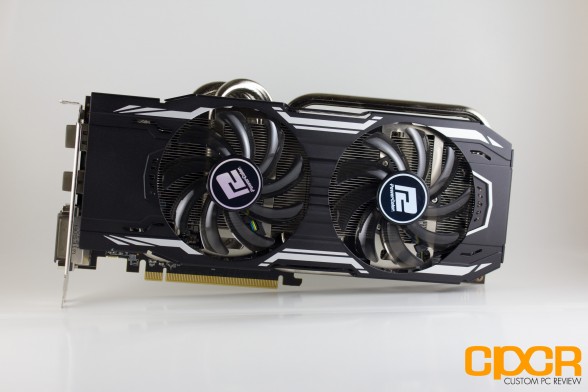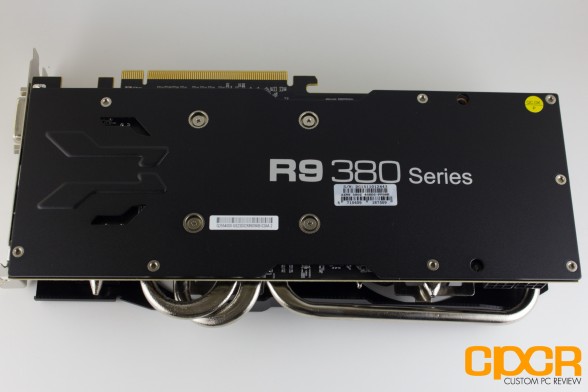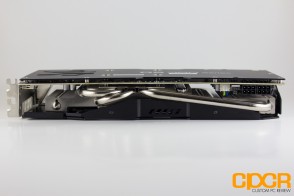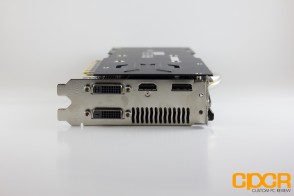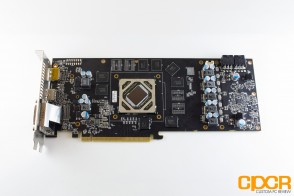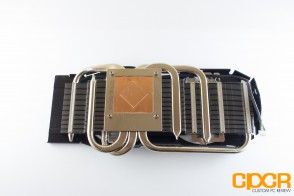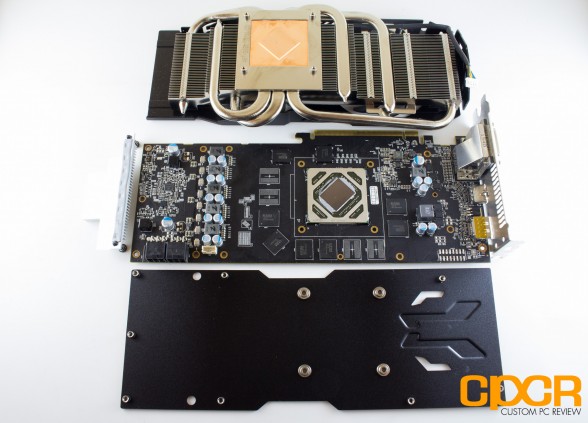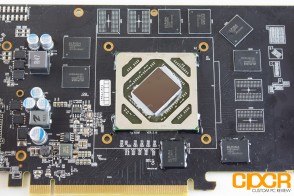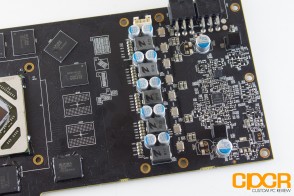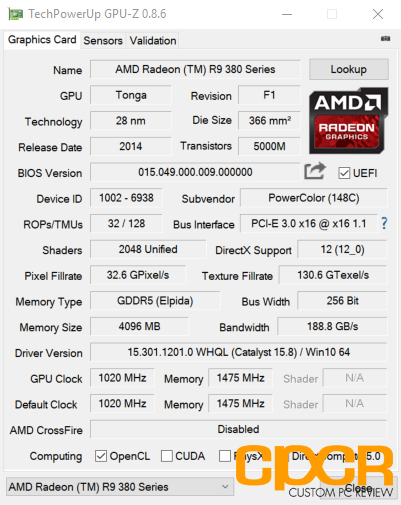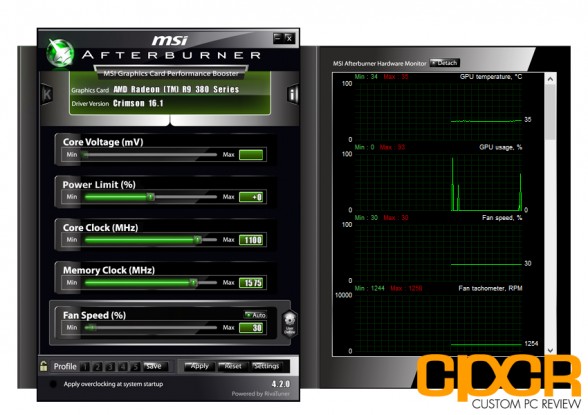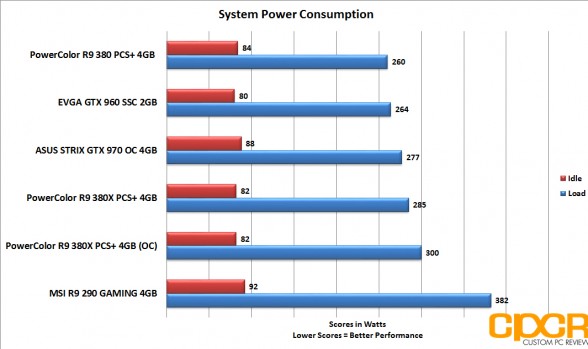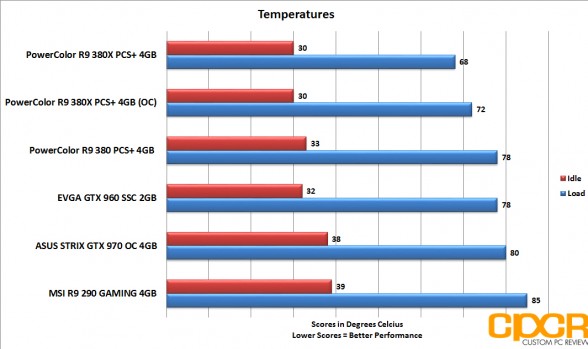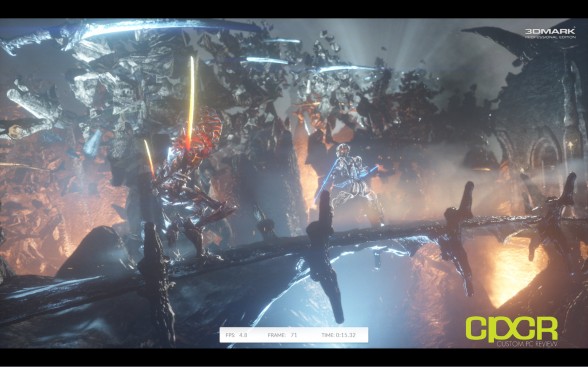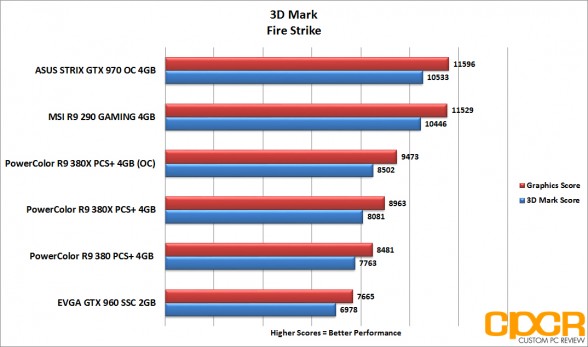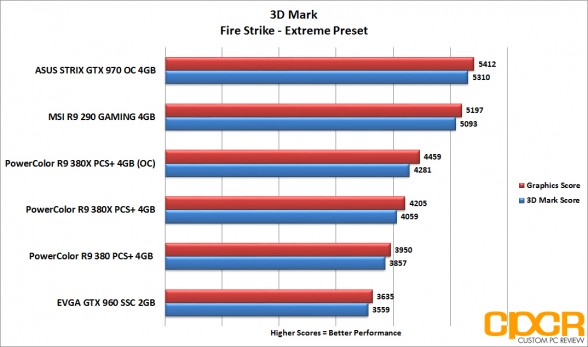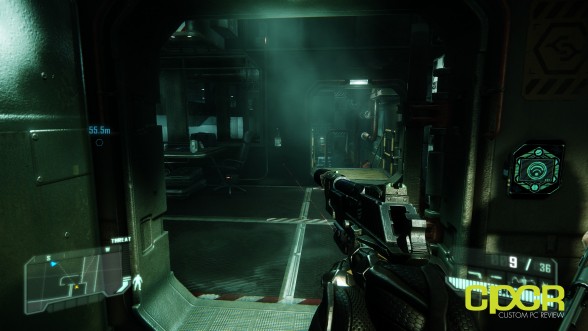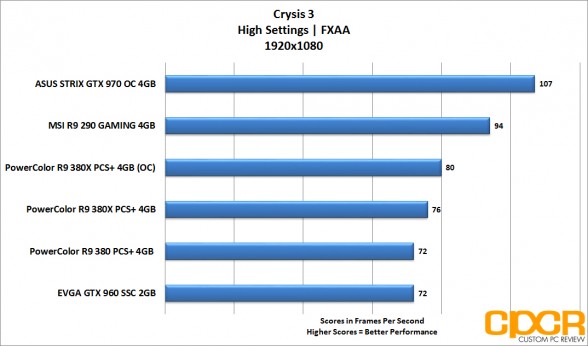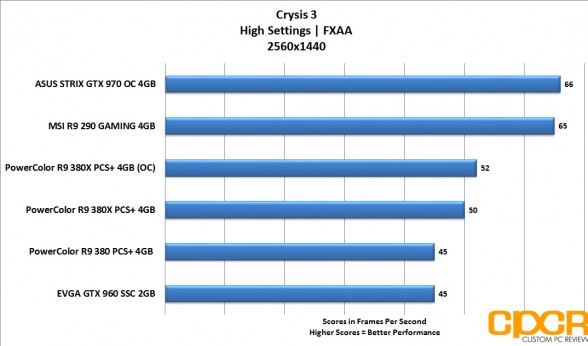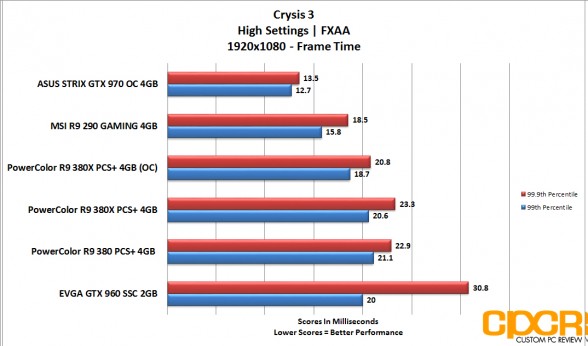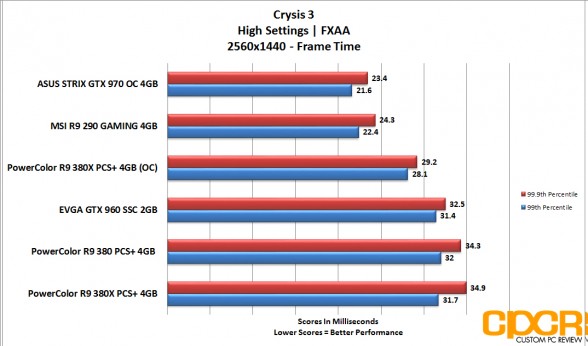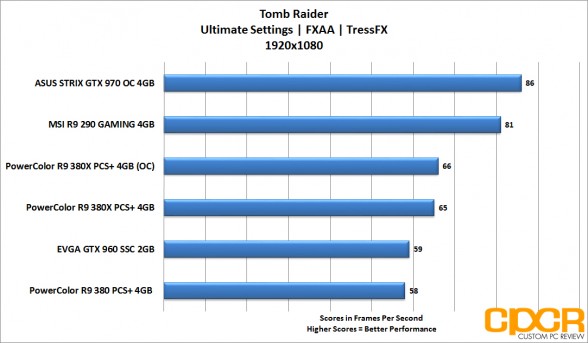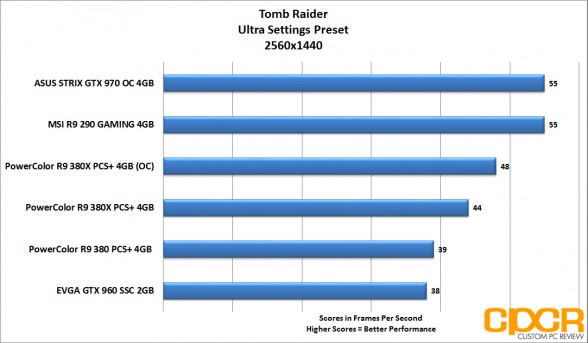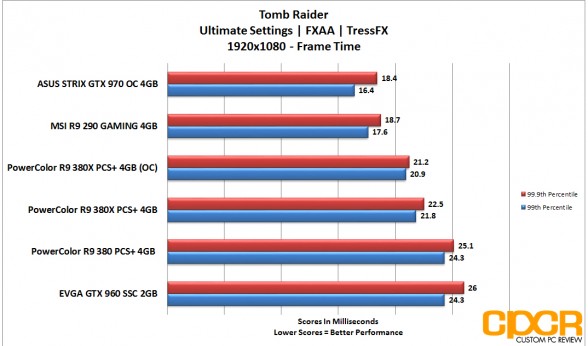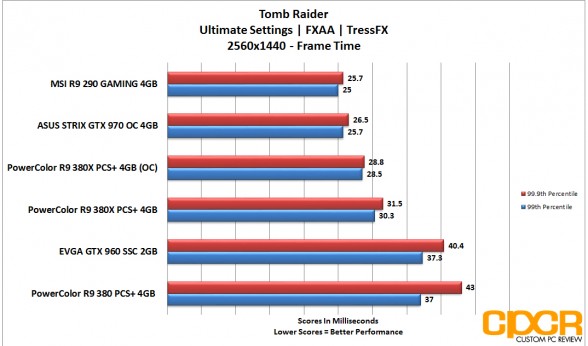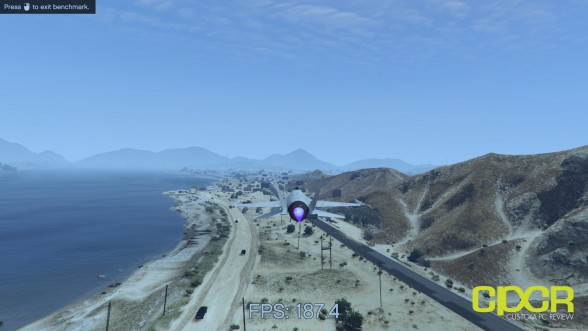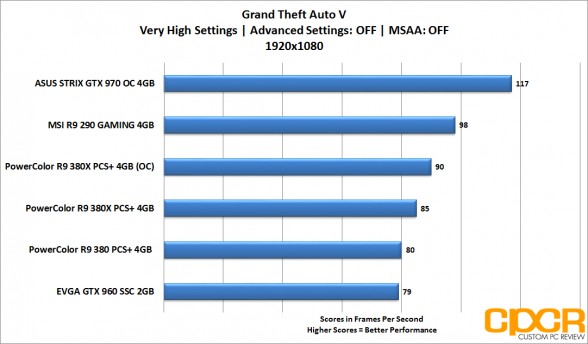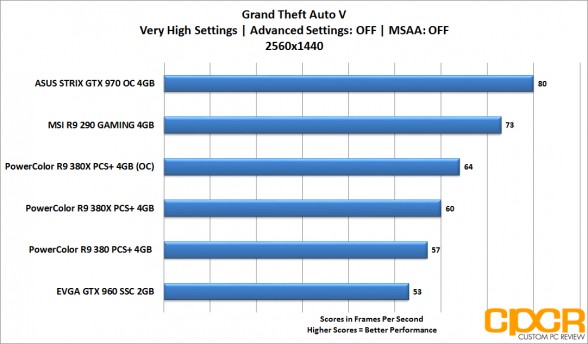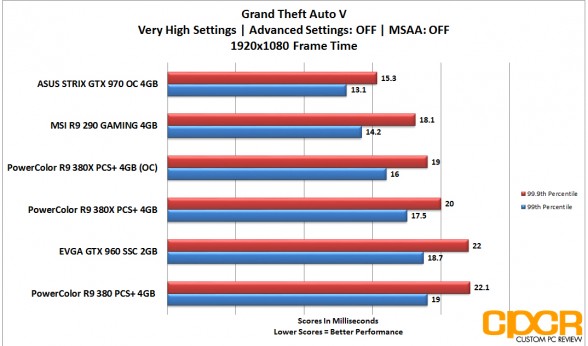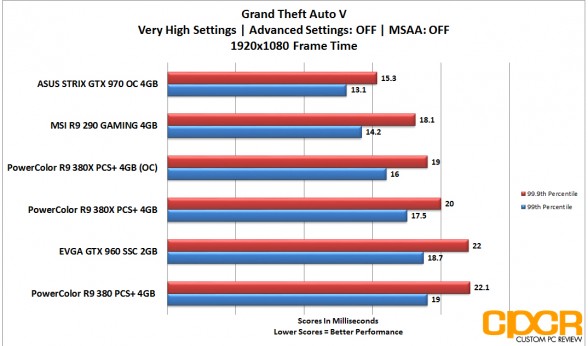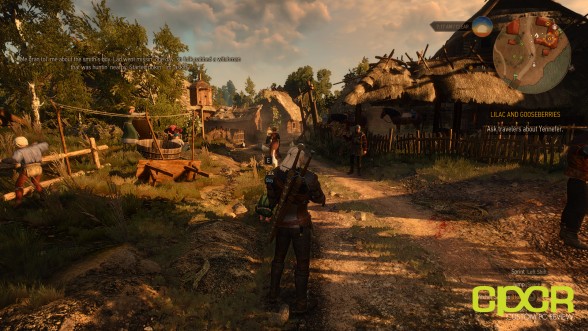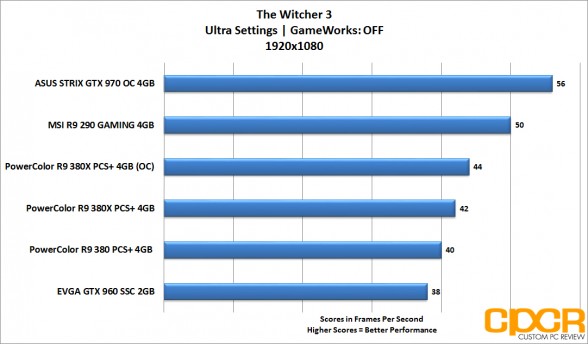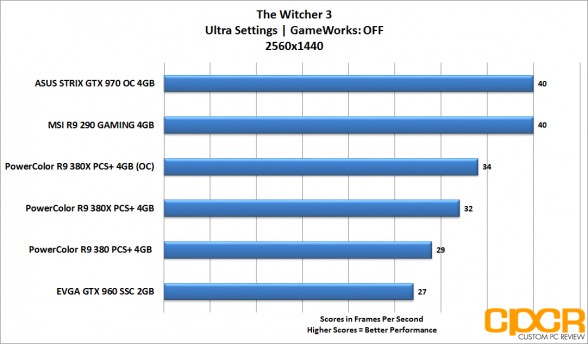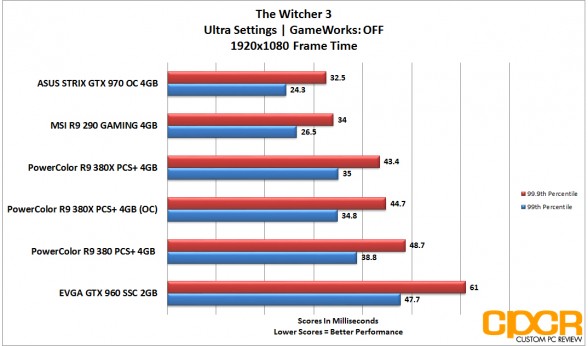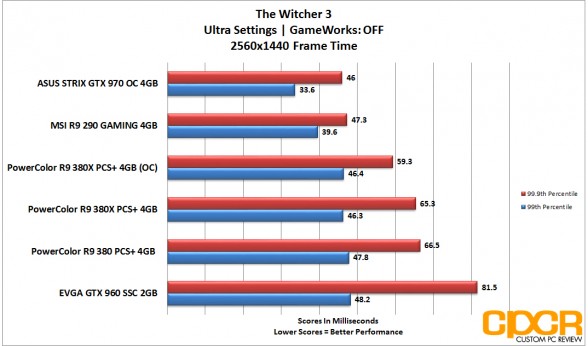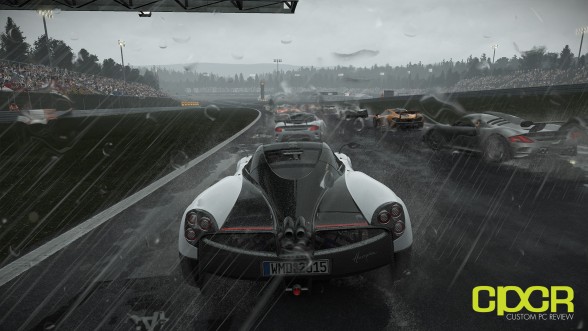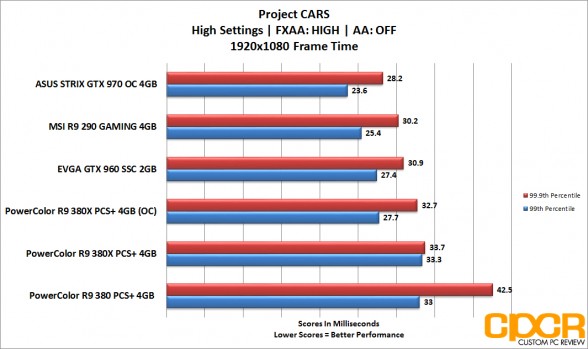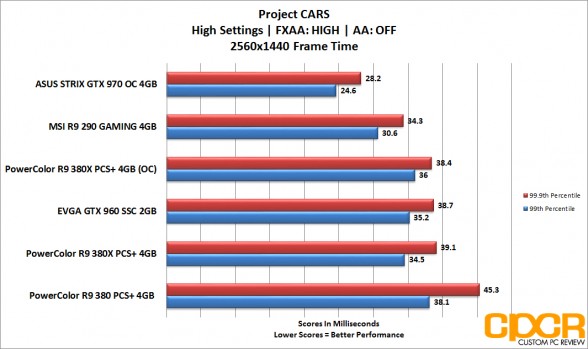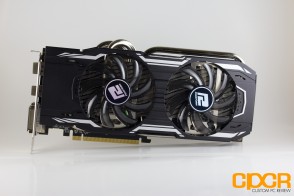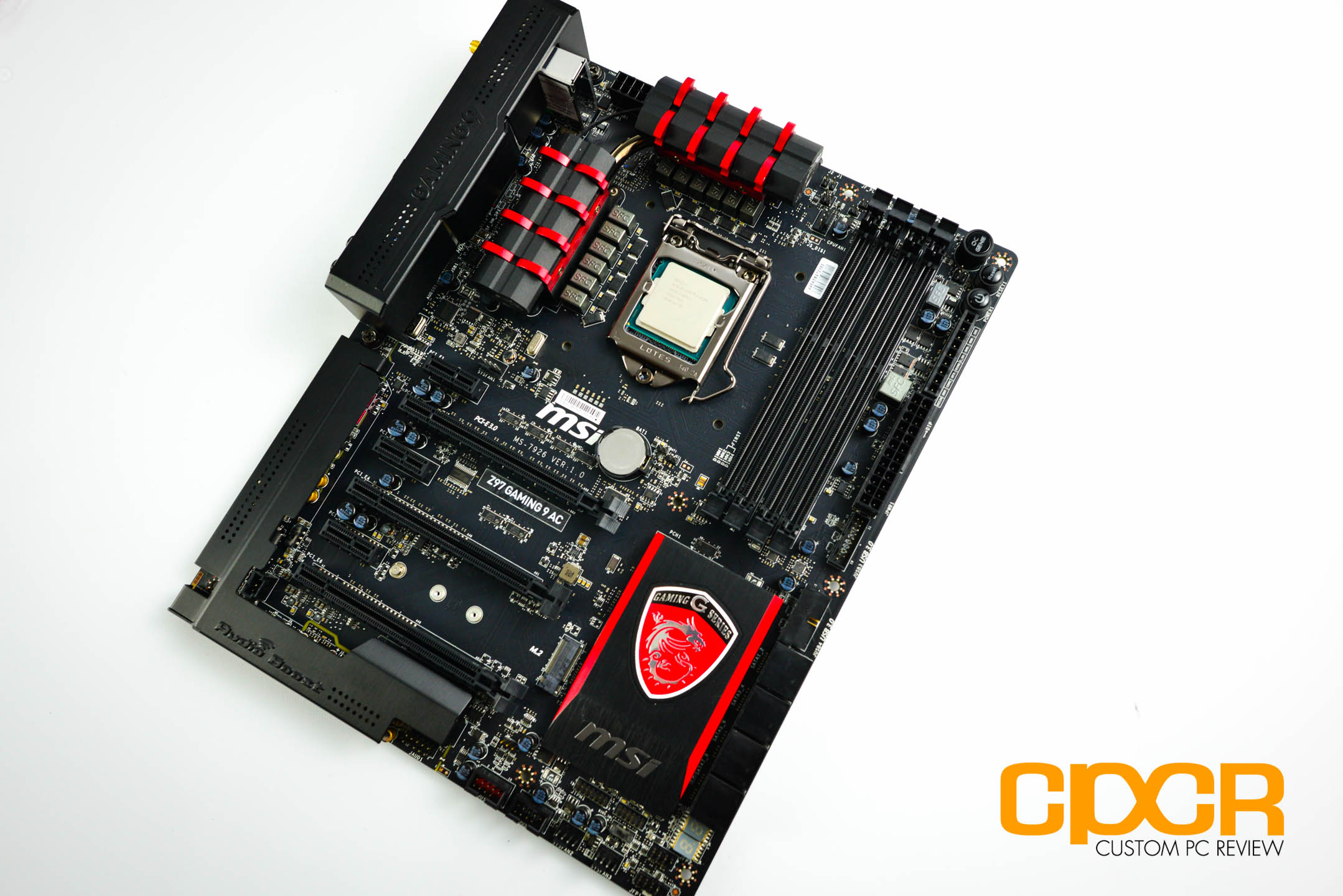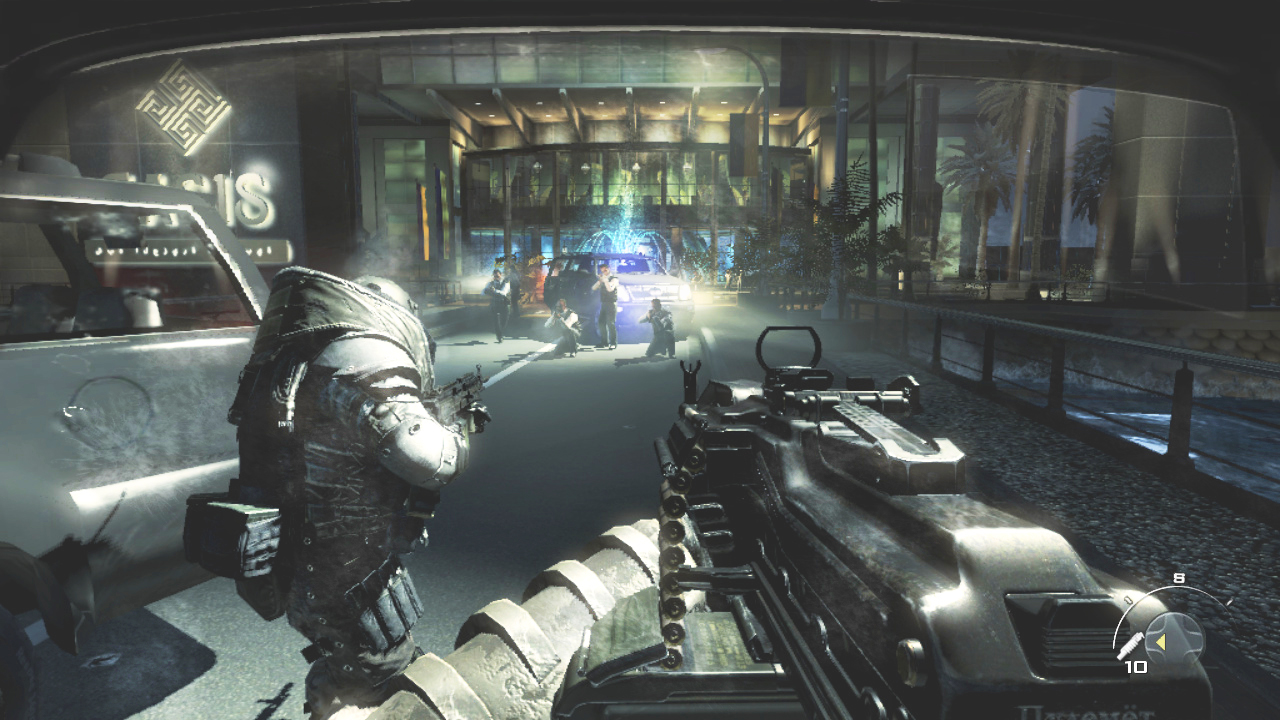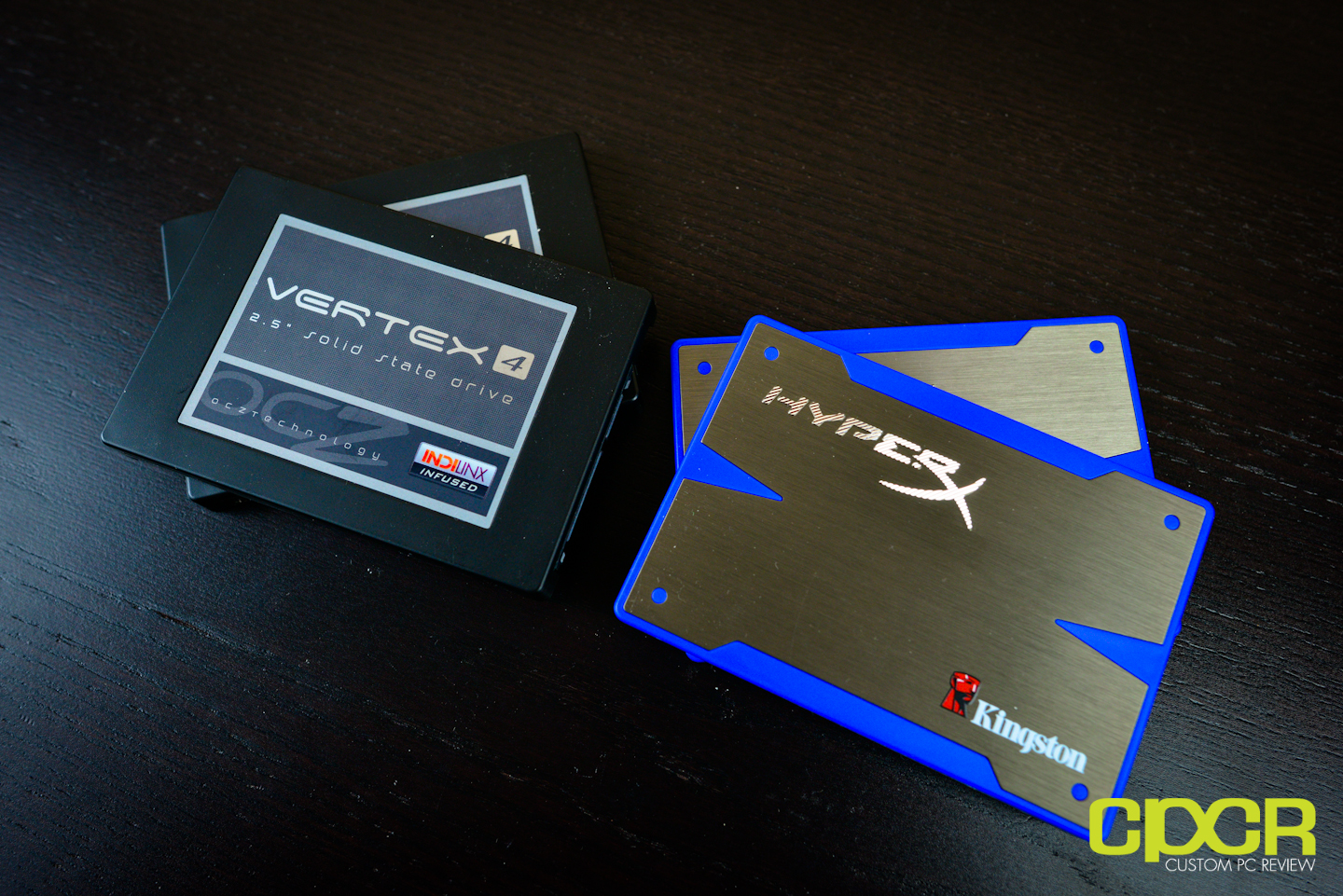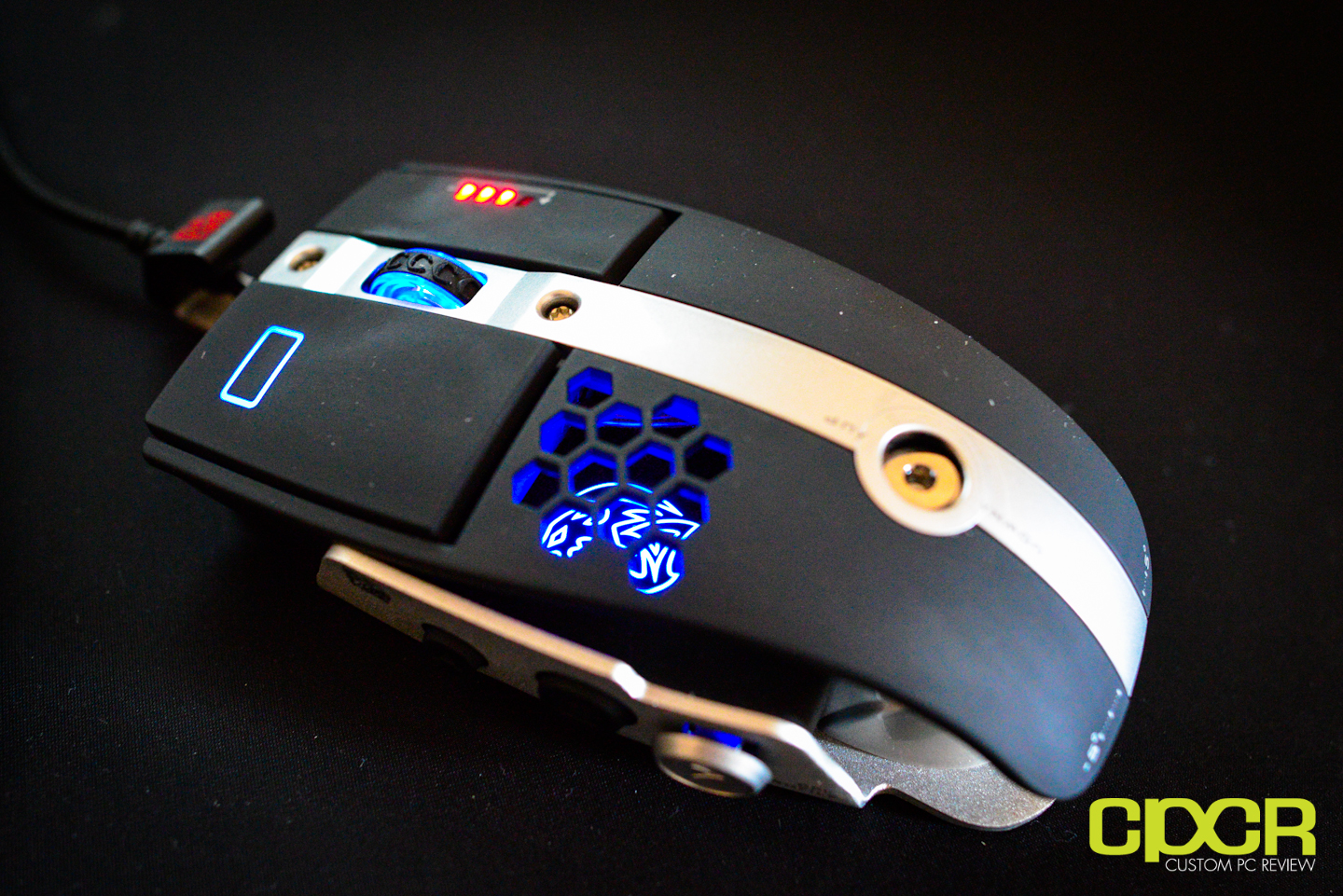[section label=1. Introduction]
The sweet spot for 1440p gaming?
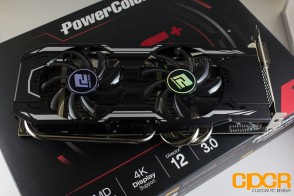 In November of last year, AMD finally released the long-awaited Radeon R9 380X, which is the first consumer graphics card the company has released to feature a full-fledged Antigua (Tonga) XT graphics core. Of course, many may be wondering what to expect from an AMD card which is priced smack in the middle between the Radeon R9 380 and the much beefier, Radeon R9 390.
In November of last year, AMD finally released the long-awaited Radeon R9 380X, which is the first consumer graphics card the company has released to feature a full-fledged Antigua (Tonga) XT graphics core. Of course, many may be wondering what to expect from an AMD card which is priced smack in the middle between the Radeon R9 380 and the much beefier, Radeon R9 390.
Today, we’re going to find out as we take a look at the PowerColor PCS+ Radeon R9 380X Myst.
| GPU | R9 380 | R9 380X | R9 390 | R9 390X |
|---|---|---|---|---|
| Codename | Antigua (Tonga) Pro | Antigua (Tonga) XT | Grenada (Hawaii) Pro | Grenada (Hawaii) XT |
| Architecture | GCN 1.2 | GCN 1.1 | ||
| Fabrication | 28nm | |||
| Core Clock (MHz) | 970 | 970 | 1000 | 1050 |
| Stream Processors | 1792 | 2048 | 2560 | 2816 |
| Texture Units | 112 | 128 | 160 | 176 |
| ROPs | 32 | 32 | 64 | 64 |
| Framebuffer | 2GB/4GB | 4GB | 8GB | |
| Memory Type | GDDR5 | |||
| Memory Interface | 256-bit | 256-bit | 512-bit | 512-bit |
| Memory Clock | 5.5 Gbps | 5.7 Gbps | 6.0 Gbps | 5.0 Gbps |
| TDP | 190W | 190W | 275W | 275W |
| Launch Price | $199-$225 | $229 | $329 | $429 |
Taking a look at the chart above we can see that the reference Radeon R9 380X features a fully unlocked Antigua XT graphics core, which is based on AMD’s GCN 1.2 architecture. We’ll also note that this fully unlocked core features a total of 2048 Stream Processors which is an increase of roughly 14% over the Radeon R9 380. It also features 18% more Texture Units and a 4% higher Memory Clock. The PowerColor PCS+ R9 380X Myst brings this even further by upping the Core Clock to 1020MHz and the Memory Clock to 5.9 Gbps, a pretty respectable increase for a factory overclock.
At $229, the PowerColor PCS+ 380X Myst is priced in line with other Radeon R9 380Xs on the market. The Radeon R9 380X itself fits right in between the Radeon R9 380 and Radeon R9 390 in pricing, which is an area NVIDIA doesn’t really currently compete in, outside of the 4GB variant of the GeForce GTX 960, which trades blows with the Radeon R9 380 depending on the application. This definitely puts AMD in a unique position as users who are looking for a bit more power than the GeForce GTX 960 or Radeon R9 380 have to offer, but don’t want to splurge on a GeForce GTX 970 or Radeon R9 390 currently have nowhere else to look other than Team Red.
That being said, how does the PowerColor PCS+ R9 380X Myst perform? Let’s find out!
[section label=2. A Closer Look]
A Closer Look at the PowerColor PCS+ 380X Myst
First we take a look at the packaging for the PowerColor PCS+ 380X Myst.
Included in the packaging, we get some basic documentation, as well as a driver installation disc, which we absolutely do not recommend using. Download the latest drivers from the internet folks, as the ones that come included in the packaging are guaranteed to be outdated. This is a point which is only further proven by the fact that PowerColor still insists on using the old ATI logo for the discs, despite the company being bought by AMD almost a decade ago.
Taking a look at the card itself; we can see a design which is much different from the PowerColor PCS+ R9 380 which we’ve reviewed in the past, trading the flashy black and red color scheme for a much simpler black and white one. That is not the only difference, however. It also trades the admittedly small 80mm fans of the R9 380 for larger 90mm ones, which feature dual ball bearings, and nine fan blades. Hopefully, this will address some of the noise concerns we had with the previous card.
Flipping the card around, we’ll find the addition of a premium backplate. It doesn’t matter how many cards we review which feature backplates, we’re always pleased to see them. This one is rather simple, featuring a mostly all black, and flat design bearing only the “R9 380 Series” branding, and no PowerColor or PCS+ logos or branding.
The card is powered by a dual 6-pin PCI-E power connectors. Looking around back, we’ll find several connectivity options, including a 2x dual-link DVI-I connectors, a single HDMI 1.4, and a single DisplayPort 1.2 connection.
Removing the cooler, and back plate we get a look at the cooler’s construction, as well as the custom PCB. The cooler itself consists of a large aluminum fin array which spans nearly the entire length of the card, running through it are three large, 8mm nickel-plated copper heat-pipes which all meet in the middle at the fully copper base. All and all, this is a solidly built cooling solution, which should provide sufficient cooling for our card and allow for some extra overclocking headroom.
Removing the cooler also gives us a look at the rest of the card’s components, which includes the 4+1+1+1 phase, all-digital Gold Power Kit VRM and PowerPak SO-8 premium MOSFETS. The VRM is cooled directly by a small aluminum finned heatsink which is attached to the board via push pins, this smaller heatsink is cooled by the airflow which exists the main fin array.
Surrounding the 28nm Antigua XT GPU, we’ll find 4GB of GDDR5 which is supplied by Elpida Memory. This is another change from the PowerColor PCS+ R9 380, which used memory from SK Hynix.
[section label=3. Testing Setup and Methodology]
PowerColor PCS+ 380X Myst Performance
Testing Setup
Haswell-E X99 Test Bench
| CPU | Intel Core i7 5960X @ 4.2GHz |
|---|---|
| Motherboard | Asrock X99 OC Formula |
| Memory | Crucial Ballistix Elite 16GB DDR4-2666 |
| Graphics | N/A |
| Boot Drive | Samsung 850 EVO 500GB M.2 SSD |
| Storage Drive | ADATA Premier SP610 1TB SSD |
| Power Supply | DEEPCOOL DQ1250 |
| CPU Cooler | DEEPCOOL GamerStorm Captain 360 |
| Case | Phanteks Enthoo Pro |
| Operating System | Windows 10 Pro |
Special thanks to Phanteks, DEEPCOOL, Asrock, and Crucial for supplying vital components for this test bench.
Testing Methodology
To test our graphics cards, we use a variety software, tools, and benchmarks. First we’ll validate the card using GPU-Z, and then test the card’s overclocking capabilities using the vendor’s software (if applicable.) Once we reach a satisfactory overclock, we’ll then test the card’s cooling performance and power draw using FurMark at both factory configurations, and while overclocked. After that, we put it through its paces using a variety of benchmarks starting with 3D Mark Fire Strike, and continuing into a number of popular gaming titles. Game performance is measured in both average FPS, as well as Frame Time, both of which are logged using the benchmark and recording tool FRAPS, and then analyzed using FRAFS. Each game is tested a minimum of 3 times with the average of those results being displayed in our scores.
All cards tested were using the latest available drivers at the time of testing, those include NVIDIA GeForce Game Ready 361.43, and AMD Radeon Crimson 16.1.
Frame Time Analysis
Frame Time Analysis is a recent addition to our graphics testing suite, it allows us to measure the overall gaming experience, and fill in the gaps that traditional FPS performance measuring leaves. Frame Time itself, is simply the amount of time it takes (in milliseconds) for the GPU to render a given frame. Higher or inconsistent Frame Time can result in a poor experience, which will be perceived as micro-stutter.
In order to measure micro-stutter, we’ll be measuring both the 99th, and 99.9th percentile. These results are essentially the worst Frame Time a user can expect both 99%, and 99.9% of the time. While every user is different, it is unlikely that most would notice anything below 30 ms, so that is what we look to achieve. In addition, we’ll want to look out for large gaps between the 99th, and 99.9th percentile as that can also result in noticeable stutter, or spikes in performance.
[section label=4. Overclocking]
PowerColor PCS+ 380X Myst Overclocking
Initial Boot
MSI Afterburner
For overclocking the PowerColor PCS+ R9 380X Myst, we’ll be using MSI Afterburner, as PowerColor does not currently provide their own utility. MSI Afterburner is a tool which is uses for monitoring, tweaking and overclocking graphics cards and works with all modern GPUs from both AMD and NVIDIA.
With some quick tweaking, we were able to increase the card’s already impressive factory overclock significantly. We managed to increase the Core Clock to 1100MHz, which is a roughly 8% increase. Along with that, we increased our Memory Clock from 1475MHz (5.9 Gbps) to 1575MHz (6.3 Gbps), a roughly 7% increase. Those are fairly decent results, which we hope will translate into significant performance increases in our tests.
[section label=5. Power Consumption and Temperatures]
PowerColor PCS+ 380X Myst Performance
Power Consumption
For power consumption testing, we’ll be measuring full system power while idle along with full system power with the graphics card running at full load using Furmark. All power consumption measurements will be measured at the outlet with a simple P3 kill-a-watt meter.
Taking a look at the chart above, we can see that the PowerColor PCS+ R9 380X does use quite a bit of power, surpassing even our ASUS Strix GTX 970. Once overclocked, the card’s power draw increases even further bringing our total system draw to 300 watts.
Temperature Testing
For idle temperature, we’ll be taking a reading when the graphics card is idle for 5 minutes after a cold boot. Load temperatures are taken after a full 30-minute burn using Furmark.
While some of you aren’t huge fans of Furmark as it creates an ultra heavy, unrealistic load on the graphics card, we feel like it’s a more useful tool as it differentiates between graphics cards that have extremely well-designed coolers and ones that simply have cooling solutions that simply pass the test, if you will. Most games these days generally don’t create enough of a load/heat to even exceed temperatures where the fans would spin up on most custom coolers so it’s difficult to adequately rank cooling solutions without using a tool like Furmark. During all tests, the GPU intake air temperature is approximately 25° Celsius.
Looking at our temperature results, we can see that the PowerColor PCS+ 380X’s cooler does a pretty decent job at keeping the card cool, even while overclocked it only gets up to 72 C under load. That’s impressive, especially considering that both EVGA GTX 960 SSC and PowerColor’s R9 380 PCS+ fair much worse at 78 C under load. Sure, none of these cards should get quite that hot under normal gaming loads, but its good to know that if you’re using the card in a less optimal situation, such as a case with poor airflow, it’ll still stay relatively cool and quiet.
[section label=6. 3D Mark]
PowerColor PCS+ 380X Myst Performance
3D Mark
The new 3D Mark, now referred to as just 3D Mark, is Futuremark’s latest update to the popular 3D Mark series of benchmarks. The updated 3D Mark now includes multiple benchmarks for cross-platform support as well as updated graphics to push the latest graphics cards to their limits.
[section label=7. Crysis 3]
PowerColor PCS+ 380X Myst Performance
Crysis 3
Crytek’s third installment of the legendary series Crysis, like its predecessors, still serves as one of the best looking, and most graphically intensive games to date. Offering photo realistic textures, advanced lighting, and a massive environments, which mix together lush organic plant life and foliage, with large, damaged and demolished buildings.
We test the game in a 60 second run during the first indoor area, which features a few firefights, explosions, and some stealth play. It is not the most graphically intensive portion of the game, but it is one of the most easily repeatable for our purposes.
Average FPS
Frame Time Variance
[section label=8. Tomb Raider]
PowerColor PCS+ 380X Myst Performance
Tomb Raider

When Tomb Raider was first showed off at E3 2012, the game quickly became one of the most highly anticipated games of the year. It had been quite some time since the last Tomb Raider game and given the popularity of the franchise, nobody could really resist a reboot of franchise especially when you’ve got Square Enix and Crystal Dynamics at the helm.
Despite the game ultimately being a multi-platform game, Tomb Raider turned out to be a fantastic port featuring numerous DX11 features such as depth of field, ambient occlusion, tessellation, etc. Even AMD pitched in as well helping developers with their TressFX real-time hair physics engine giving Lara Croft more realistic hair than ever before.
Average FPS
Frame Time Variance
[section label=9. Grand Theft Auto V]
PowerColor PCS+ 380X Myst Performance
Grand Theft Auto V
The hotly anticipated PC release of Rockstar Games’ fifth installment of their Grand Theft Auto franchise, easily proves once again, that when it comes to open-world games, no one does it better. With lots of new features and graphical enhancements built specifically for the PC version, it’s no wonder it took them so long to optimize it. With advanced features such as tessellation, ambient occlusion, realistic shadows, and lighting, mixed with the largest open-world map in franchise history, this is one beautiful, well-optimized PC title.
We test Grand Theft Auto 5 using the last scene in the game’s built-in benchmarking tool. We test on ‘Very High’ settings
Average FPS
Frame Time Variance
[section label=10. The Witcher 3: Wild Hunt]
PowerColor PCS+ 380X Myst Performance
The Witcher 3: Wild Hunt
CD Projekt RED’s The Witcher series, has long been accredited with being some of the most beautiful, and graphically demanding PC titles and its latest installment, The Witcher 3: Wild Hunt, is no exception. With beautiful, large open-world environments, detailed charter designs, high-resolution textures, and advanced features such as God Rays, and Volumetric Fog, in addition to a slew post-processing effects, this is definitely one impressive looking game.
We test The Witcher 3 with a 60 second lap around the first village you come across in the campaign, this is one of the best places for testing as it exhibits some of the game’s most graphically intense features such as God Rays, and Volumetric Fog, while offering very little variance, which is difficult to find in most open-world games. We test with NVIDIA HairWorks off as we find it puts an artificial gap between otherwise similarly performing AMD and NVIDIA GPUs.
Average FPS
Frame Time Variance
[section label=11. Project CARS]
PowerColor PCS+ 380X Myst Performance
Project CARS
Next-gen racing simulator Project CARS was met with much anticipation when developer Slightly Mad Studios first announced the community assisted project. While it may not be the definitive choice for racing sim enthusiasts, it is easily one of the best-looking racing games available, featuring photorealistic vehicle models, real-world tracks, and realistic rain and weather effects. Despite some initial performance issues on AMD hardware, which have been mostly patched, it is still one of the best racing simulator available for testing graphics performance.
We test the game using the in-game replay system, the race lasts 2 minutes and 15 seconds, and takes place on the Nürburgring race track, with extreme weather effects enabled.
Average FPS
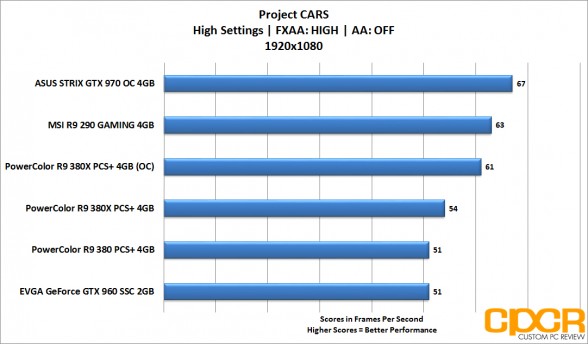
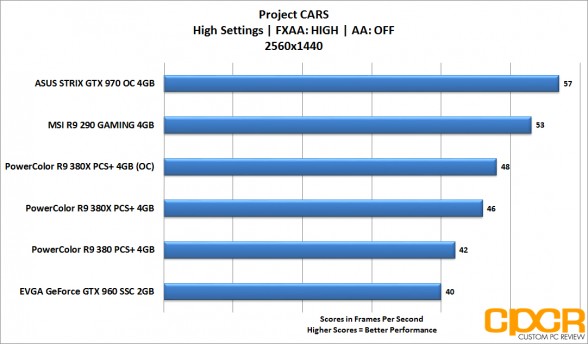
Frame Time Variance
[section label=12. Conclusion]
PowerColor PCS+ 380X Myst Conclusions
Looking at our results, we can see that the R9 380X Myst outpaces the standard Radeon R9 380 by an average of about 10%, faring quite a bit better in 1440p than its cut down little brother. The PowerColor PCS+ R9 380X Myst we tested is not only factory overclocked, but offers a decent amount of overclocking headroom which pushes the performance difference between it and the Radeon R9 380 and GeForce GTX 960 even further.
One of the things I found most impressive about the PowerColor PCS+ R9 380X Myst is its cooling capabilities, especially when compared to the cooler of the PowerColor PCS+ R9 380. The larger fans and heatsink allow for a much cooler and quieter thermal solution, which not only allows for better performance but also a better experience overall while gaming. This is especially great for those who sit close to their gaming systems or those looking to game in the living room.
Another thing I was impressed with and quite surprised by is how well the PowerColor PCS+ R9 380X Myst performed at 1440p. Sure, it’s outpaced by the likes of the higher end Radeon R9 290 and GeForce GTX 970, but you’d be hard pressed to find either of those solutions for anywhere near $229, without looking at the used market. In fact, at its current pricing, I’d argue that the Radeon R9 380X is definitely the sweet spot for 1440p gaming as it offers playable framerates at the highest settings in most games, and can easily hit 60 FPS in most if not all of those titles by just turning down the settings a bit – a trade-off I believe most users would be more than willing to make.
Overall the PowerColor PCS+ R9 380X is a solid graphics card with strong additional overclocking capability, a great cooling solution, and a reasonable price. Recommended!
Sample provided by: PowerColor
Available at: Newegg

